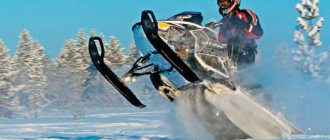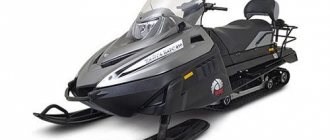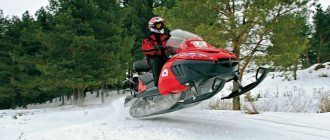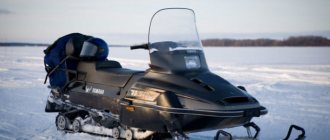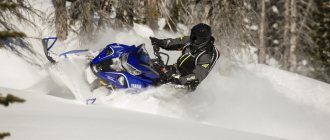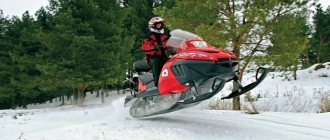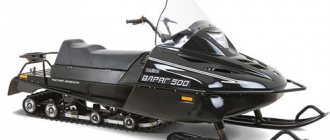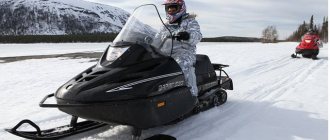The BRP Ski Do Summit 800 is a high-tech snowmobile for demanding users who need a machine for professional tasks. This snowmobile allows you to overcome any obstacles, be it smooth and well-worn roads, or deep snow with a large number of obstacles, stones and trees. The equipment was developed taking into account modern international standards and norms that are in demand today. Based on this, it can be argued that the Skido Summit 800 BRP is highly relevant at the moment. The developers used a combination of proven technical solutions and innovative technologies in the car, and the result was a technologically advanced and maintainable design. Before us is a machine developed on the proven REV-XP platform. The model is equipped with a powerful power plant, which will be the envy of even the strongest famous competitors of brands such as Yamaha. The manufacturer positions the Skido 800 as one of its flagship snowmobiles with cutting-edge benefits.
The developers paid special attention to organizing the workspace. In particular, the driver's seat, the combination of controls and the arrangement of instruments have undergone a radical redesign. The seat has a two-seater layout and is equipped with backrests for the front and rear passengers, as well as heated handles. Heating is provided in the steering column switches and some controls - for example, the gas trigger. As for the instruments, they do not glare in the sun and display in detail all the information about the condition of the snowmobile. We are talking about readings of engine temperature and oil pressure, as well as speed and current mileage.
Returning to the driving position, note that it can be adjusted in height - however, this feature is also relevant for the adjustable steering column. Thanks to this, the snowmobile can be operated while sitting or standing, which is very important for professional users. The seat can be made into a single seat, and in this case it will be possible to place additional cargo in the rear (instead of the passenger). In addition, another luggage compartment is provided under the driver's seat - it is carefully sealed from moisture and can accommodate various accessories that will be useful on a long journey.
Technical characteristics of the Summit snowmobile: 670, 800, 850
The Canadian company producing snowmobiles SKI - DOO has gained popularity among fans of extreme snow racing around the world. Designed for difficult trails with snow drifts and icy surfaces. Models are designed with fuel economy in mind. Considering that the equipment is available in several modifications, the parameters of each version differ.
Snowmobiles BRP SKI - DOO 670, 800, 850 have the following average technical indicators:
- Gas engine;
- two-carburetor fuel system;
- liquid cooling system;
- CVT gearbox;
- presence of reverse;
- height to windshield - 1 m;
- fuel tank volume - 35 - 43 liters;
- oil tank - 3.5 l;
- dimensions - 3.2 - 1.1 - 1.15 meters;
- weight - 210 - 320 kg;
- average caterpillar width -40 cm;
- length - 154, 165, 175 inches;
- spatial design of the aluminum alloy chassis with front RAS and rear TMOTION suspensions;
- hydraulic brake discs;
- transmission equipped with a pDrive variator and electronic reverse, combined with the engine;
- REV platforms, Gen 4 REV;
- SHOT system (based on innovative developments that simplify engine warm-up);
- centered motor system;
- suspension RAS-3;
- Brembo braking system.
000_moto_0112_050
You look at the characteristics of both snowmobiles and you are amazed: the numbers seem to be absolutely identical cars, and the pictures in the advertising brochure clearly hint that the test subjects are, if not twins, but certainly brothers. But as soon as I saw them in person, skepticism about different names for the same car disappeared. The similarities end with the appearance and 800 cc engine. And the fundamental difference is that FreeRide, whose name itself speaks of its career guidance, is built on the basis of the Ski-Doo Summit “mountain bike,” while BoonDocker (which is tempting to be called a chipmunk) uses the Lynx platform. The engines of both are in-line two-stroke “eight hundred” with direct fuel injection, equipped with an electronic reverse system (no gears or gearboxes, just the engine in reverse mode starts in the opposite direction, this is a two-stroke engine!). No “lowering” or electric starters with batteries - everything is subordinated to weight reduction. I was amused by the reverse buttons on both cars: small rubber-coated boxes, attached to the steering wheels with ordinary plastic clamps. On the one hand, it seems to be a “collective farm”, but on the other, you soberly understand that there is simply no need for anything else here. The trend for dual-mode suspension hydraulic adjustments seems to be affecting more than just sportbikes - the FreeRide has separate compression damping adjustments for high and low speed piston rod movement on each shock. I won’t go into detail about the catchiness of the design - you can see for yourself, but I’ll just say that if the “chipmunk” is available only in black, the FreeRide comes in albino form - without any labels, and the owner chooses one of eight color options and glues the snowflake himself.
With a manual starter, even at -32°C, both snowmobiles start quite easily: if warmed up, then with half a turn, and when cold, a maximum of ten times. And what is important, the force on the “rope starter” is adequately small, despite the fact that on the other side of the barricades the compression of two 400 cc “boilers” resists. Direct injection and dosed lubrication systems do their job: the exhaust does not stink of burning, but has a barely noticeable thoroughbred smell, unique only to two-stroke engines.
I started driving around this couple with FreeRide. Colleagues frightened him: they say that he is very harsh, capricious and uncontrollable. But with every meter of virgin snow left behind the toothy caterpillar, I became more and more fused with the car. To say that there is a lot of power is to say nothing. But a two-stroke is a two-stroke - all the thrust is only “from above” and “in the middle”. Matching the character of the engine is the resourceful temperament of the variator - it turns on only after 4500 rpm, which immediately pulls the 154-inch track into the axle box when starting off. The main thing is not to close the gas and not let the car dig in - in a moment FreeRide, like a grasshopper, jumps forward, throwing out a powerful stream of snow from under the caterpillar, and rushes headlong. One hundred, one hundred and forty, one hundred and sixty... The frosty surroundings on the sides of the road begin to blur, and the speedometer needle seems to go crazy. The “claws” of the caterpillar and effective brakes help stop this outrage, because on a two-stroke, closing the throttle does not lead to braking. Yes, this is, of course, not a full-fledged mountain Summit, but you can’t blame it for insufficient cross-country ability. Although the two-stroke engine is sharp, it has a great advantage in weight over four-stroke engines, which is especially important when being rescued from white captivity: it trampled the car, raised its “tail” and rushed on, raising clouds of snow sparkling in the polar sun. After half an hour of driving, the suspensions “thawed out” and began to really work: at any speed and with any irregularities, they smooth out almost all the harshness of the shaking with a bang, and even during landings after jumps they do not break through. It doesn’t seem like a feather bed, and the snowmobile doesn’t gallop like a saiga. The stock positions of the regulators turned out to be quite suitable for my average weight (70 kg). And also about comfort: this seemingly pure sports equipment is not without pleasant little things like adjustable heating and good wind protection. The only thing I would like to improve is that snow constantly accumulates and tramples at the bottom of the footwells, which has to be regularly picked out and pulled out - the standard “drainage” holes instantly become clogged and frozen.
But with controllability, everything is not so clear. I had no reason to doubt either the rigidity of the frame or the correctness of the steering kinematics, but it turned out to be very difficult to check all the reactions of the car. A hefty track and wide skis - inherited features of the Summit family, of course, do not make handling zero, but in order to push the car into a turn along the desired trajectory, you have to work hard. In most cases, especially with an inexperienced rider, the car just goes wherever it wants. Here you have to work hard with your body, loading this or that ski - this is the only way the free ride turns into a “where it needs to be” ride. But as soon as I swapped cars with a colleague, the Free Ride turned out to be much more obedient under the hundredweight of his weight.
To summarize, I can say that the FreeRide is truly a machine for complete breakaway, and on any snow, but it is strictly contraindicated to let dummies near it - the equipment is really very restive.
But who is really mad is the “chipmunk” BoonDocker. What a monster of hell! Although the engine here is the same - the 800th two-stroke from Rotax, in terms of dynamics it beats the FreeRide effortlessly. As soon as you press the gas on the compacted snow, the car actually gets on the track, cutting through the air with skis and rushes forward with wild frenzy. It takes your hands off the steering wheel so much that sometimes it seems as if it’s not a snowmobile, but a sled with a solid fuel accelerator under the seat. The dynamics are at the level of a liter sportbike, the longitudinal overloads are under 1g, too. I've ridden many snowmobiles, but even the BRP MX-Z (what a racing icon it is) doesn't give the same feeling of adrenaline-fueled recklessness as the Chipmunk. The transmission settings match the explosive engine: not a single joule of energy screwed into the variator by the crankshaft is wasted - this can explain the almost constant axle of the track (by the way, it is shorter here than on the FreeRide - 146 inches). BoonDocker itself is much thinner than FreeRide: from the seat cushion to the ski track. Narrow, fast and precise, like a cheetah, I would classify this “chipmunk” not as a rodent, but as a predator. Moreover, the car’s handling is also to match: it writes turning arcs at any speed, as if according to a pattern, at the same time forgiving minor errors in control. Although this is a little strange: since ancient times, Ski-doo family cars have been sharper and more maneuverable than those built on the Lynx platform. The joy of riding a “chipmunk” was overshadowed by the fact that our world is imperfect, because you still have to pay for everything. Even though the track on the Chipmunk is only an inch narrower and eight inches shorter, it does not have as developed lugs as the FreeRide - if you hesitate a little and slow down in deep powder, the car strives to “sit down.” Hence the conclusion is that BoonDocker is a less passable vehicle than its opponent from the Ski-Doo series. This Lynx is more designed for relatively flat and dense snow - there it can fully demonstrate its, without exaggeration, wildest dynamics and refined handling. And as soon as you find a suitable hummock or mound, a mad chipmunk turns into a flying chipmunk - it loses contact with the ground much more readily than a “free” chipmunk. It seems that the shock absorbers on it do not have such a rich set of adjustments, and the cars weigh almost the same, but the fact, as they say, is obvious.
Advantages of the SKI snowmobile - DOO SUMMIT
During the development of the chassis and engine using the technology of “tying” to each other, the engineers managed to combine the requirements for weight distribution, achieving placement of the engine clearly in the middle.
BRP SKI - DOO snowmobiles are distinguished by power and sensitivity, thanks to the following qualities.
Chassis
The main features in the form of a forward-shifted driver's seat and A-shaped front linkage arms have not changed. The new Rev Gen 4 pyramidal platform and the engine located centrally closer to the front frame distribute the load evenly and facilitate easy sliding of the vehicle. The CVT transmission is located more vertically, the driver now has the opportunity to sit more comfortably with his legs stretched out, which means that the car is now suitable for long trips, hard driving or driving while standing.
Thanks to titanic efforts, the platform developers managed to reduce the overall weight of the structure. This was possible due to changes in the composition and thickness of the metal, as well as the size and shape of the parts.
Engine
The snowmobiles are equipped with Rotax “E-TEC” two-stroke engines with an electronic control system, producing up to 165 horsepower, which is 10 to 15 horses more than their rivals. High speed and rapid acceleration are ensured by the pDrive variator, working in tandem with the engine. Some models in this line are equipped with the latest SHOT engine starting system. Its peculiarity is that the charge for starting is accumulated in the capacitor when the engine is turned on; to turn it on, just press the button. The crankcase cooling system ensures reliable operation and increases power by cooling the intake air. The increased rigidity of solid cylinder blocks gives the engine an additional power resource. The high-performance pump supplies the engine with an intense flow of cooled air. The new generation Rotax 3D Rave exhaust valve partially neutralizes the harmfulness of exhaust gases and helps save fuel.
The engine capacity, depending on the model, ranges from 800 to 1200 cubic meters, the maximum speed reaches 160 km/h.
Video
The equipment has successfully passed all stages of factory testing, and its reliability has been confirmed by ordinary users, as well as professionals and athletes. The snowmobile is designed for operation in harsh climatic zones; it is capable of moving on severe off-road conditions. Especially for this, the machine is equipped with a massive chassis. Despite its heavy weight and large dimensions, this snowmobile performs excellently on any road. This is facilitated by the revolutionary tMotion rear suspension with a modern control arm design that is reinforced with articulated joints. The lower part of the suspension, if necessary, tilts two degrees in different directions, in the horizontal direction. In other words, the tilt occurs during sharp maneuvering. In this case, the lateral steering/suspension shift function is activated so that the snowmobile is more willing to corner. To increase directional stability on uneven and slippery roads, the snowmobile was equipped with a special Powder Max II track. Its peculiarity lies in its record lug lug, which is 63 mm. At the same time, we will also add a slip suspension and support rollers, which had to be shifted from the edges to the central part. This arrangement was not chosen by chance, because thanks to it the edge of the track bends when the snowmobile is tilted. The edge of the track does not have stiffeners as standard, but this technology (called Flex-Edge) can be ordered as an option. This technology is especially useful when driving on serious off-road conditions.
Among other features of the chassis of the BRP Skido 800 snowmobile, let us pay attention to its rear part, namely the tracks. They are a massive structure, protruding far back. Because of this, the length of the vehicle increases significantly, but at the same time the cross-country ability significantly increases. The width of the tracks is 410 mm, and the length of the transverse stiffeners reaches 310 mm. For comparison, for conventional tracks this indicator extends across the entire width of the tracks. In this regard, the snowmobile in question looks preferable, and thanks to this length, the deformable zone on each edge of the track does not exceed 50 mm in width. In other words, this feature allows for quick maneuvers, and the machine is able to turn with the ease of a “high-track” snowmobile, without losing the benefits of a wide track. This effect is achieved on any surface - in a deep snowdrift, or on a knurled, flat road. The front chassis, in turn, includes traditional double A-arms, complemented by proprietary HPG Plus shock absorbers with 200 mm of travel.
The ski track width reaches 950 mm, but this figure can be adjusted downward, depending on the characteristics of the road surface. In addition, the developers have ensured ease of movement along steep mountainous terrain and slopes - for this purpose, special teeth are built into the upper suspension arms, thanks to which the driver’s feet cannot slip at the most inopportune moment.
Other features of the BRP Summit snowmobile
- Sporty look.
- Optimal design shape for mountainous areas.
- Short mountain seat.
- Low windshield.
- Straight steering wheel.
- Heated seats, steering columns, instruments.
- Dashboard with the ability to control all indicators.
- Improved chassis due to a track lighter by 4.5 kg, thanks to which the vehicle accelerates and stops faster.
- The efficiency of shock absorbers and increased suspension travel are achieved through load distribution during descent and ascent, as well as optimal balance.
- Improved frame profile, high edges of the footpegs.
- The beveled tunnel, narrowed at the top, complemented by a heat exchanger prevents snow from sticking to its rear part.
- Reduced instrument panel shifted to the bottom.
Gear ratios
For small sprocket:
-146-inch model: 23 teeth for sea level height, 21 teeth for higher height
-154 and 163 inch models: 21 teeth for sea level work, 19 teeth for higher altitudes
For a large sprocket:
-146 and 154 inch models: 49 teeth for both sea level and high altitude performance
-163-inch model: 51 teeth for working at any height.
The drive sprocket on all models and for both configurations (sea level and high altitude riding) uses an eight-tooth drive element.
The XM Summit X features forward-mounted handlebars and skis (compared to the XP), and side panels with cutouts for footwells. The foot wells themselves are deeper. All this makes the driving position more comfortable, and the snowmobile more obedient.
The S-36 suspension package complements the rMotion rear suspension perfectly, and the Pilot DS2 skis keep the snow firmly on the slope.
Ergonomics are well thought out. Thanks to the comfortable curved handlebar, the driver's hands and wrists are positioned naturally. Heating controls are located on the dashboard. Other controls on the handles, such as reverse and the emergency engine switch, are positioned to prevent accidental operation.
The XM Summit X comes with a feature-rich digital or analog instrument panel that faces up because most mountain snowmobile riders prefer to ride standing up. The instrument panel displays all important engine parameters and also shows the height. We liked this large scoreboard and easy to read numbers.
There is a glove compartment behind the dashboard. It's great to have somewhere to put a spare pair of gloves or glasses.
The seat is designed very well, the fabric has a pleasant texture. Nothing prevents you from throwing your legs from one footrest to another. In fact, the snowmobile can be controlled expertly if you keep both feet on the appropriate platforms. There is a small luggage compartment behind the seat, which is also very pleasing.
The painted tunnel prevents snow from freezing. Ice and snow do not accumulate in hard running boards because special holes are made in them. The tunnel supports Ski-Doo's LinQ mounting system, so you can easily attach a variety of additional panniers or bags.
Overall, the XM Summit X is a satisfying mountain sled. For 2015, Ski-Doo also offers sea-level versions of the Summit X. These are long, light and comfortable machines that can be driven for many kilometers in deep, untouched snow.
Based on our experience, we can confidently say that the steering wheel is as easy to control as a feather, and its best position is at the factory. If you drive along an already paved or simply hard-packed path, the nose of the snowmobile bounces and tries to move to the side, because the impacts are reflected into the steering wheel. It's not as bad as on previous years' XP Summit models, but it's still there and it's quite annoying.
The XM Summit X can sometimes get bogged down in light, fluffy snow, but that doesn't happen with the T3 Summit. But this can be minimized by staying close to the handlebars or adjusting the restraint straps to control weight distribution. Every mountain sled has its quirks, and that's what we found in the Summit X.
Finally, I would like to note that the XM Summit X is a very popular snowmobile, but it is perhaps overshadowed by the new T3. But this does not mean that it’s time to write off XM Summit X - it is still good and strong.
Owner reviews
Snowmobile equipment is subjected to enormous loads while driving, which means that before purchasing a unit, the consumer must know which model to choose so that it meets the requirements of reliability and safety. Owners of the BRP SKI - DOO Summit appreciated the excellent maneuverability, ease of operation, and ease of movement on this equipment. It is advised to adhere to the manufacturer’s operating recommendations, then trouble-free operation of the machine in difficult conditions is guaranteed.
Mostly positive reviews speak about the quality of snowmobiles. I am pleased with the purchase of the BRP SKI - DOO Summit 800. The model pleased me with its strong engine, which allowed us to reveal the full potential of the machine. There is complete order with handling and dynamics, which cannot be said about reliability. I already had to change the tracks and skis. Otherwise, I’m happy with the purchase, I don’t plan to sell, since off-road driving is a priority than replacing parts.
BRP Skido Summit 800 is a decent snowmobile for professional needs, fishing, hunting. The car drives well on a flat, icy road - for example, on a frozen lake. In six months there hasn’t been a single breakdown, I’m happy with the ability to ride with two people, heated handles, ease of operation. The only drawback is high fuel consumption, but this is understandable - the car is powerful, consumes 25 liters per 100 kilometers, because of this you have to carry an additional can of gasoline with you, but this is a minor drawback.
He has been using the equipment for more than a year, and says that this time was enough to draw conclusions. Among the advantages, he notes well-thought-out ergonomics - due to the impressive visor, the instruments do not glare in the sun, are easy to read, and the massive windshield protects from snow and wind. I'm pleased with the fairly intense acceleration - 100 km/h, and the build quality. The engine requires high quality fuel, gasoline consumption is not high. Recommends snowmobile equipment for purchase.
I warn newcomers who bought the BRP Summit about its lightness. The engine immediately responds to pressure on the trigger, becomes sharp, powerful, and is eager to rear up from careless movement.
Engine
The BRP Skido Summit 800 snowmobile is equipped with an 80R Power TEK gasoline power unit, which is used in the more technologically advanced Ski Doo Summit X 800R model, which differs only in minor modifications. With a displacement of 0.8 liters, the engine develops 150 horsepower. The developers managed to achieve a high degree of boost without reducing engine life. The engine demonstrates endurance and stable operation in any speed range. To maintain engine reliability at a high level, BRP specialists equipped the internal combustion engine with a fuel system consisting of two TM-40 carburetors. Thanks to its compact two-cylinder design, the 800R Power TEK two-stroke engine is lightweight and compact. Due to this, it was possible to reduce the weight of the snowmobile and increase maneuverability. Also responsible for the reliability of the internal combustion engine is the liquid cooling system, a feature of which is the effective prevention of overheating of all internal combustion engine components at relatively high temperatures. There is also a preheater and an electric starter. These components ensure uninterrupted engine starting at any low temperature.
